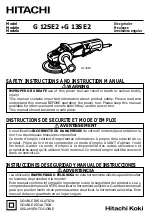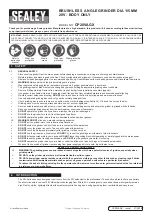
9 — English
OPERATION
LOCK-OFF BUTTON
See Figure 4, page 12.
The lock-off button is located on the handle above the
switch trigger. You must depress the lock-off button in
order to pull the switch trigger. The lock resets each time
the trigger is released.
SWITCH TRIGGER
See Figure 4, page 12.
To turn the grinder
ON, depress and hold lock-off button,
then depress the switch trigger. To turn it
OFF, release the
switch trigger.
POSITIONING THE GUARD
See Figures 5 - 6, page 13.
The guard on the grinder should be correctly positioned
depending on which side the handle is mounted. Never use
the grinder without the guard correctly in place.
WARNING:
Never place the guard so that it is in front of the grinder.
This could result in serious injury because sparks and
loose particles thrown from the grinding wheel would be
directed toward the operator. Always place the guard in
the correct location as shown.
To reposition the guard:
Remove the battery pack.
Unlock the guard clasp by pulling the clasp out, away
from the grinder.
Rotate the guard to its correct position as shown.
Lock the guard clasp by pushing the clasp in.
NOTE: Be sure the raised ridge on the guard is seated
in the groove on the bearing cap. Never use the grinder
without the guard in place and properly adjusted.
OPERATING THE GRINDER
See Figure 7, page 13.
Always carefully select and use grinding wheels that are
recommended for the material to be ground. Make sure
that the minimum operating speed of any accessory wheel
selected is 6,500 r/min. or more. The grinding wheel provided
with the grinder is suitable for grinding welds, preparing
surfaces to be welded, grinding structural steel, and grinding
stainless steel.
To operate the grinder:
Secure all work in a vise or clamp to a workbench.
DANGER:
Never use the grinder with the guard removed. It has been
designed for use only with the guard installed. Attempting
to use grinder with guard removed will result in loose
particles being thrown against the operator resulting in
serious personal injury.
Hold the grinder in front and away from you with both
hands, keeping the grinding wheel clear of the workpiece.
Turn on the grinder and let the motor and grinding wheel
build up to full speed.
Lower the grinder gradually until the grinding wheel
contacts the workpiece.
WARNING:
To prevent loss of control and possible serious personal
injury, always operate the grinder with both hands,
keeping one hand on the side handle.
Keep the grinder tilted at an angle from 5° to 15° and
continuously moving at a steady, consistent pace.
NOTICE:
If the grinder is held in one spot too long, it will gouge
and cut grooves in the workpiece. If the grinder is held
at too sharp an angle, it will also gouge the workpiece
because of concentration of pressure on a small area.
Use just enough pressure to keep the grinder from
chattering or bouncing.
NOTE: Heavy pressure will decrease the grinder’s speed and
put a strain on the motor. Normally the weight of the tool
alone is adequate for most grinding jobs. Use light pressure
when grinding jagged edges or loose bolts where there is the
potential for the grinder to snag on the metal edge.
Lift the grinder away from the workpiece before turning
off the grinder.










































